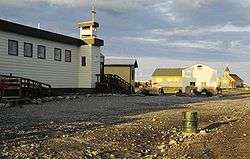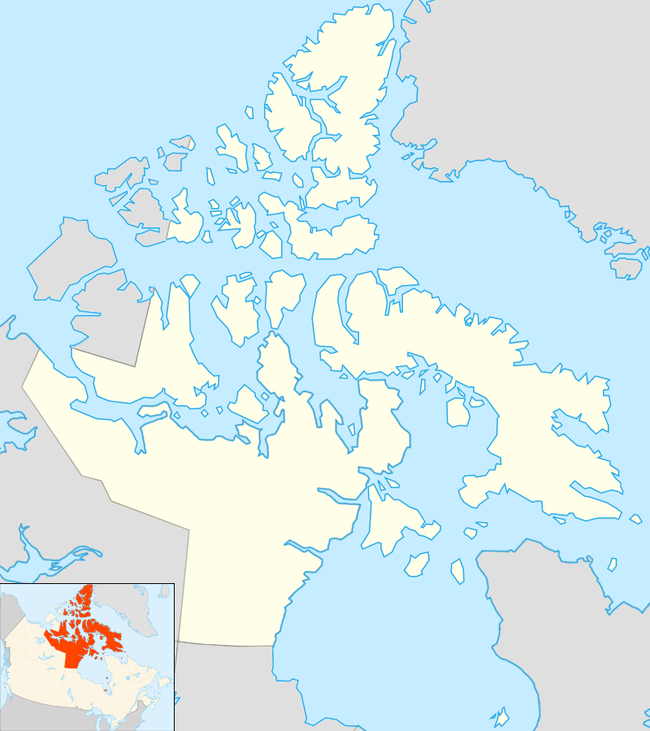Arviat
Arviat (Inuktitut pronunciation: [aʁviˈat], syllabics: ᐊᕐᕕᐊᑦ; formerly called Eskimo Point until 1 June 1989) (2016 population 2,657;[4] Population Centre 2,514[5]) is a predominantly Inuit hamlet located within Inuit Nunangat on the western shore of Hudson Bay in the Kivalliq Region of Nunavut, Canada. Arviat ("place of the bowhead whale") is derived from the Inuktitut word arviq meaning "Bowhead whale". Earlier in history, its name was Tikirajualaaq ("a little long point"), and Ittaliurvik, ("a place where the people make tents").[9]
Arviat ᐊᕐᕕᐊᑦ | |
|---|---|
 Two of the churches in Arviat | |
 Arviat  Arviat | |
| Coordinates: 61°06′29″N 094°03′25″W | |
| Country | Canada |
| Territory | Nunavut |
| Region | Kivalliq |
| Electoral district | Arviat North-Whale Cove Arviat South |
| Government | |
| • Type | Hamlet |
| • Mayor | Robert (Bob) Leonard |
| • Senior Administrative Officer | Steve England |
| • MLAs Arviat North-Whale Cove | John Main |
| • MLA Arviat South | Joe Savikataaq |
| Area | |
| • Total | 132.07 km2 (50.99 sq mi) |
| • Population Centre | 2.45 km2 (0.95 sq mi) |
| Elevation | 10 m (30 ft) |
| Population | |
| • Total | 2,657 |
| • Density | 20/km2 (52/sq mi) |
| • Population Centre | 2,514 |
| • Population Centre density | 1,000/km2 (2,700/sq mi) |
| Demonyms | Arviaqmiut,[7] Arviatmiut[8] |
| Time zone | UTC−05:00 (CST) |
| • Summer (DST) | UTC−04:00 (CDT) |
| Postal code | X0C 0E0 |
| Area code(s) | 867 |
| Website | www.arviat.ca |
Community
Arviat is the southernmost community on the Nunavut mainland and is close to the geographical centre of Canada. In Arviat, Inuktitut and English are primarily spoken, having the third largest population in Nunavut, behind Rankin Inlet and Iqaluit. From the 2011 census to the 2016 census there was a population increase of 14.6%.[4] The mayor of Arviat is Joe Savikataaq (Jr.).[1] The hamlet of Arviat also possesses a Tim Hortons in the Northern Store and a self-serve Tim Hortons in the Quick Stop (owned by Northern Store).
Cargo and passenger air service is provided by Calm Air/First Air out of Arviat Airport.
.jpg)
Hunting and fishing are very active in the community; they are the primary source of sustenance. Four locally operated stores - Padlei Co-op, Northern Stores, Artic Connection and Eskimo Point Lumber Supply - carry a wide range of products.
To the south, the town of Churchill, Manitoba is accessible by boat (summer and fall only), snowmobile and Bombardier from Arviat and is often travelled to for supplies.
Arviat is well known around the Arctic for its artistic qualities. It is a thriving community with many talented musicians: Susan Aglukark, a well known musician; Simon "Johnny Cash of the North" Sigyariaq; the band Uniaqtuq, with Arsene, Pelagie and Mary Angalik; the Arviat Band, with John and Billy Kuksuk, Paul Kattau and others; the Irksuk band, played by Paul Irksuk and sons. All have had CDs recorded commercially.
Many types of wildlife are abundant. Within the vicinity of Arviat, polar bears, millions of migratory birds, beluga whales, and caribou are often spotted.
The only access is by air and snowmobile, but the Nunavut government and the federal Senate member for Nunavut, Dennis Patterson, are investigating the possibility of a highway from Thompson, Lynn Lake, or Gillam to Rankin Inlet, through Arviat. Like other Arctic coast communities there is an annual sealift but it is not available to passengers.
Arviat was originally inhabited by the Paallirmiut, a coastal/inland Inuit band. In 1957, dying of starvation, the last remaining Ihalmiut, another Caribou Inuit band, were relocated to Arviat by the Royal Canadian Mounted Police. Though there are differences between the two bands, they recognize a need to work together in order to benefit the community.[10]
Arviat was featured in Dancing Towards the Light, a 2017 CBC News short film and article telling the story of the hamlet's annual dance competition.[11][12]
Recreation
The Hudson Bay Quest sled-dog race was run from Churchill to Arviat for the first time in 2004.
Internet
The community has been served by the Qiniq network since 2005. Qiniq is a fixed wireless service to homes and businesses, connecting to the outside world via a satellite backbone. The Qiniq network is designed and operated by SSI Micro. In 2017, the network was upgraded to 4G LTE technology, and 2G-GSM for mobile voice.
Climate
Based on the Köppen climate classification Arviat has a subarctic climate, but has a polar climate by the Nordenskjöld classification, and is north of the Arctic tree line. Spring is slow to warm up, with June being cooler than September and May cooler than October. With a yearly mean of −9.3 °C (15.3 °F) it is the third-warmest in Nunavut and the maximum of 33.9 °C (93.0 °F) recorded on 22 July 1973[13] is second only to Kugluktuk. Arviat has a yearly rainfall of 174.4 mm (6.87 in), the fourth-wettest in Nunavut, but only 112.4 cm (44.3 in) of snow, the third-least.[14]
| Climate data for Arviat Airport, 1981–2010 normals, extremes 1973–present | |||||||||||||
|---|---|---|---|---|---|---|---|---|---|---|---|---|---|
| Month | Jan | Feb | Mar | Apr | May | Jun | Jul | Aug | Sep | Oct | Nov | Dec | Year |
| Record high °C (°F) | −1.5 (29.3) |
−1.5 (29.3) |
3.5 (38.3) |
4.0 (39.2) |
14.5 (58.1) |
30.8 (87.4) |
33.9 (93.0) |
30.0 (86.0) |
23.0 (73.4) |
18.1 (64.6) |
2.1 (35.8) |
−0.4 (31.3) |
33.9 (93.0) |
| Average high °C (°F) | −25.4 (−13.7) |
−24.2 (−11.6) |
−18.0 (−0.4) |
−9.1 (15.6) |
−1.2 (29.8) |
7.7 (45.9) |
15.1 (59.2) |
14.2 (57.6) |
7.3 (45.1) |
−1.0 (30.2) |
−12.0 (10.4) |
−20.3 (−4.5) |
−5.6 (21.9) |
| Daily mean °C (°F) | −29.3 (−20.7) |
−28.3 (−18.9) |
−22.8 (−9.0) |
−14.0 (6.8) |
−4.3 (24.3) |
4.4 (39.9) |
11.1 (52.0) |
10.8 (51.4) |
4.8 (40.6) |
−3.6 (25.5) |
−16.1 (3.0) |
−24.1 (−11.4) |
−9.3 (15.3) |
| Average low °C (°F) | −33.1 (−27.6) |
−32.4 (−26.3) |
−27.5 (−17.5) |
−18.7 (−1.7) |
−7.4 (18.7) |
1.0 (33.8) |
7.0 (44.6) |
7.3 (45.1) |
2.2 (36.0) |
−6.2 (20.8) |
−20.1 (−4.2) |
−27.9 (−18.2) |
−13.0 (8.6) |
| Record low °C (°F) | −48.3 (−54.9) |
−47.0 (−52.6) |
−41.5 (−42.7) |
−36.7 (−34.1) |
−26.7 (−16.1) |
−11.0 (12.2) |
−4.0 (24.8) |
−0.6 (30.9) |
−8.3 (17.1) |
−26.0 (−14.8) |
−34.0 (−29.2) |
−42.5 (−44.5) |
−48.3 (−54.9) |
| Average precipitation mm (inches) | 10.1 (0.40) |
6.6 (0.26) |
11.4 (0.45) |
12.5 (0.49) |
18.2 (0.72) |
29.6 (1.17) |
36.7 (1.44) |
56.0 (2.20) |
44.0 (1.73) |
24.5 (0.96) |
18.6 (0.73) |
18.3 (0.72) |
286.5 (11.28) |
| Average rainfall mm (inches) | 0.0 (0.0) |
0.0 (0.0) |
0.0 (0.0) |
0.5 (0.02) |
6.1 (0.24) |
26.3 (1.04) |
36.7 (1.44) |
56.0 (2.20) |
41.2 (1.62) |
7.6 (0.30) |
0.0 (0.0) |
0.0 (0.0) |
174.4 (6.87) |
| Average snowfall cm (inches) | 10.1 (4.0) |
6.6 (2.6) |
11.4 (4.5) |
12.1 (4.8) |
12.1 (4.8) |
3.2 (1.3) |
0.0 (0.0) |
0.0 (0.0) |
2.8 (1.1) |
16.9 (6.7) |
18.8 (7.4) |
18.3 (7.2) |
112.4 (44.3) |
| Average precipitation days (≥ 0.2 mm) | 7.4 | 7.2 | 9.1 | 7.1 | 7.6 | 8.0 | 8.9 | 14.1 | 12.6 | 10.8 | 10.3 | 8.1 | 111.3 |
| Average rainy days (≥ 0.2 mm) | 0.0 | 0.0 | 0.0 | 0.3 | 2.0 | 7.4 | 8.9 | 14.1 | 11.6 | 2.8 | 0.0 | 0.0 | 47.0 |
| Average snowy days (≥ 0.2 cm) | 7.4 | 7.2 | 9.1 | 7.0 | 5.8 | 0.8 | 0.0 | 0.0 | 1.1 | 8.2 | 10.3 | 8.1 | 65.0 |
| Average relative humidity (%) | 69.1 | 69.9 | 74.4 | 79.8 | 84.6 | 76.8 | 72.7 | 74.7 | 74.6 | 84.1 | 80.7 | 73.3 | 76.2 |
| Source: Environment Canada[14][15] | |||||||||||||
See also
References
- Nunavummiut elect new municipal leaders
- Results for the constituency of Arviat North-Whale Cove Archived 13 November 2013 at the Wayback Machine at Elections Nunavut
- Results for the constituency of Arviat South Archived 14 November 2013 at the Wayback Machine at Elections Nunavut
- "Census Profile, 2016 Census". Statistics Canada. Retrieved 18 February 2017.
- "Population Centre". Statistics Canada. 2011. Retrieved 3 March 2012.
- Elevation at airport. Canada Flight Supplement. Effective 0901Z 30 January 2020 to 0901Z 26 March 2020.
- Demonyms—From coast to coast to coastArchived 2016-07-21 at the Wayback Machine
- Arctic College NewsArchived July 6, 2011, at the Wayback Machine
- "Arviat, Nunavut". nu.ca. Archived from the original on 14 August 2009. Retrieved 1 January 2008.
- "About Arviat". inuitarteskimoart.com. Archived from the original on 27 May 2011. Retrieved 26 December 2007.
- "Dancing towards the light". CBC news. Retrieved 19 April 2020.
- Dancing Towards the Light, retrieved 19 April 2020 (IMDB)
- "Extremes for Arviat". Canada Weather Stats. (Data from) Environment and Climate Change Canada. 4 November 2019. Retrieved 4 November 2019.
- "Arviat A" (CSV (4222 KB)). Canadian Climate Normals 1981–2010. Environment Canada. Climate ID: 2300MKF. Retrieved 30 September 2013.
- "Arviat Climate". Canadian Climate Data. Environment Canada. Retrieved 26 May 2017.
Further reading
- Canada Mortgage and Housing Corporation. An Examination of the Use of Domestic Space by Inuit Families Living in Arviat, Nunavut. [Ottawa]: CMHC, 2004.
- Dana, Leo, and R Anderson, The evolution of entrepreneurship in Arviat: the southernmost community of mainland Nunavut, http://www.inderscience.com/search/index.php?action=record&rec_id=43473
- Inuit Gallery of Vancouver. Arviat Artists of the Past, Present, and Future. Vancouver: Inuit Gallery of Vancouver, 1997. ISBN 0-9682123-1-X
- Kalluak, Mark. Pelts to Stone A History of Arts & Crafts Production in Arviat. [Ottawa]: Indian and Northern Affairs Canada, 1993. ISBN 0-662-20847-1
- Maguire, Mary, and Lynn McAlpine. Attautsikut/Together Understanding Culture, Change and Success in Qitiqliq Secondary School and Arviat. Exemplary schools project technical report, 8. Toronto: Canadian Education Association, 1995. ISBN 0-920315-86-0
- Sharp, Jason M. Ground Truthing of Linear Magnetic Anomalies Near Arviat, Nunavut Territory. Yellowknife, NT: Indian and Northern Affairs Canada, NWT eology Division, 1999.
- Swinton, George. Arviat Eskimo Point. Vancouver: Marion Scott Gallery, 1989. ISBN 0-921634-06-4
- Tyrrell, M. 2006. "Making Sense of Contaminants: A Case Study of Arviat, Nunavut". Arctic. 59, no. 4: 370-380.
External links
| Wikimedia Commons has media related to Arviat. |